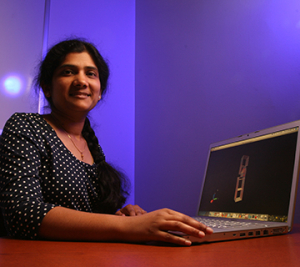Yashashree Kulkarni, associate professor of mechanical engineering at UH Cullen College of Engineering, earned a three-year $225,400 grant from the National Science Foundation to study mechanisms of deformation in cobalt with high-density stacking faults.
Cobalt in the form of thin films is ubiquitous in magnetic data storage devices as well as microelectromechanical and nanoelectromechanical devices.
However, Kulkarni and her Texas A&M University collaborator Xinghang Zhang are exploring engineering processes that produce stronger versions of different crystalline forms of cobalt with improved ductility. The combination of strength and ductility in one material is highly desirable for structural engineering applications, yet somewhat uncommon in the materials science world. For example, making steel stronger by adding carbon makes it increasingly brittle, and materials that are naturally ductile like gold and silver are not strong.
When deformed, most crystalline materials that are ductile by nature form stacking faults, or planar defects, until they fail. Environmental stressors can cause natural formation of moderate numbers of stacking faults in cobalt and other crystalline materials, but Zhang has developed a method in his laboratory for prefabrication of cobalt with high-density stacking faults.
He has demonstrated that dense or closely-spaced preexisting stacking faults in cobalt interact with defects created subsequently to provide not only increased strength but also improved deformability. Kulkarni is performing computational simulations to understand the atomistic underpinnings of the phenomenon.
“Zhang is designing cobalt microstructures at the nanoscale, and we’re performing simulations on million-atom samples on supercomputers,” Kulkarni said. “Stacking faults are conventionally thought of as defects generated when material deforms. To my knowledge, no one has looked at turning these stacking faults into mechanisms for strengthening.”
While past research conducted individually and collaboratively by Kulkarni and Zhang specifically focused on methods to improve strength and ductility in copper for structural applications, this collaboration also emphasizes understanding the universal atomistic mechanisms responsible for such properties in order to apply them to any crystalline material.
Furthermore, the joint venture provides the student research groups at the different institutions with opportunities to exchange complementary knowledge through visits, lectures and seminars as well as frequent video conferences.
“As an engineer, discovering mechanisms that can make materials stronger and more ductile is exciting because it opens up avenues for designing novel materials for structural needs,” Kulkarni said. “So we want to see how these planar defects lead to high strength and deformability at the scale of atoms.”
